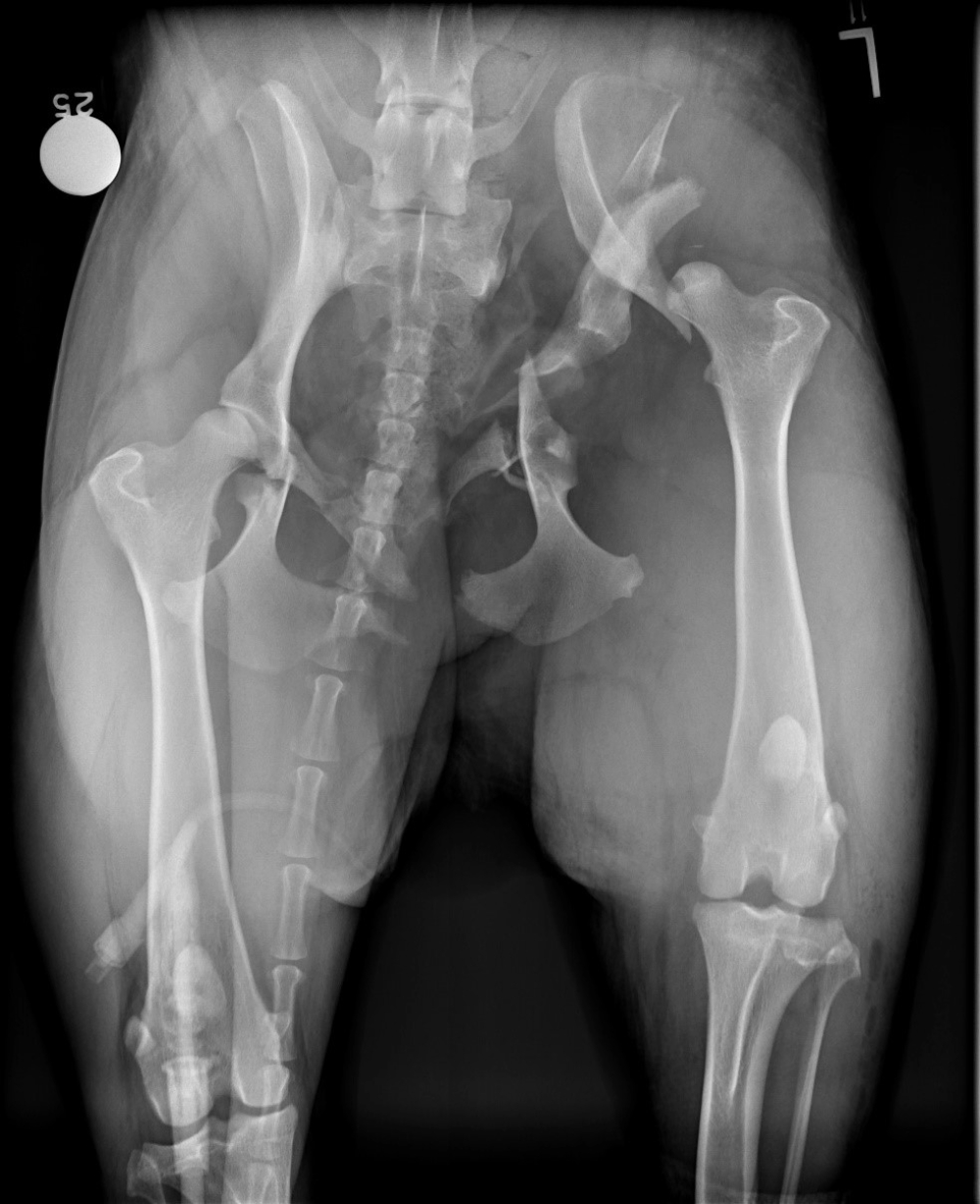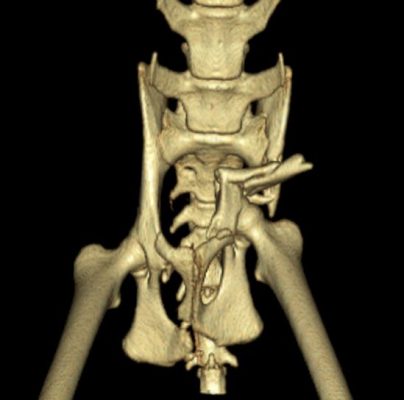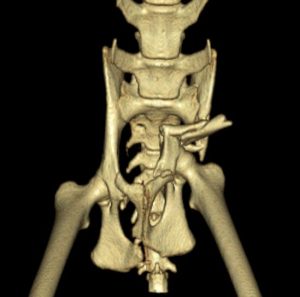Pelvic Fracture Management
Questions and Answers
A two-year-old German Shepherd presents to you following being hit by a car. Pelvic radiographs reveal multiple pelvic fractures and a left sacroiliac luxation. The patient has no neurological deficits. Once the patient is systemically stable, you plan to repair the left and right sides separately under staged anaesthetic events. Which side would you choose to address first?

Answer
There are two major considerations when deciding which side to repair first. If there are neurological deficits, then generally the affected side is operated first to avoid further damage to entrapped nerves occurring during reduction of the other side. In the absence of neurological deficits, the side where anatomic reduction is either more important, or more feasible is generally operated first.
In this case, the acetabular fracture on the right is anatomically reconstructible while the fracture on the left is not. As such, the right side would generally be operated first. If the left were operated first, and was malreduced, which is almost inevitable with a fracture of this severity, this may render anatomical reconstruction of the right side impossible.
How did you get on? This question and answer is from Karen Perry, tutor on the Online Mini Series Course ‘Pelvic Fracture Management’. Make sure you’re up to date with your management of these challenging cases when you register for this fully flexible online course.
Pelvic Fracture Management
Online Mini Series Course

- Learn about the Preoperative Assessment and Planning of Pelvic Fractures in this mini series
- Compare and contrast advantages and disadvantages of different implant systems
- Work through largely case-based approaches focusing on complications and postoperative considerations
- You have a whole year’s access to recorded sessions and study notes for reviewing key points
- Superb value for money – you learn without travelling or paying for accommodation, childcare or petcare
- Watch the recordings on your iPad, mobile, PC or tablet
- Self-assessment quiz to ‘release’ your 8 hours CPD certification
What will I learn on this course?
Session 1
Preoperative Assessment and Planning

- Articulate the extensive trauma potentially associated with pelvic fractures and potential for additional injuries
- Appreciate the importance of a neurological examination in patients with pelvic fractures and potential impacts on therapeutic decision-making
- Optimize patient positioning for radiography including special views if advanced imaging is not available
- Consider advantages of advanced imaging and for which cases these may be particularly relevant
- Recognize common patterns of pelvic fracture
- Discuss how to prioritize injuries and repairs in patients with pelvic fractures
- Articulate principles of lag screw fixation and tension band fixation
- Discuss advantages and disadvantages of locking plate technology in management of pelvic fractures
Session 2
Intraoperative Considerations for Common Fracture Patterns

- Describe the lateral approach to the ilium through gluteal roll-up and gluteal-roll down approaches
- Describe combining the lateral approach to the ilium with the craniolateral approach to the hip
- Describe the approach to the craniodorsal and caudodorsal aspects of the hip joint via osteotomy of the greater trochanter
- Articulate when each of the above approaches may be preferable for a given case
- Discuss a range of techniques to achieve and maintain reduction of various pelvic fracture configurations
- Compare and contrast advantages and disadvantages of different implant systems
- Communicate methods of achieving implant purchase in areas where bone stock is limited
- Compare prognoses for articular fractures with primary repair or salvage surgery
Session 3
Complications, Postoperative Considerations and Putting it all Together

- Articulate decision-making for a pelvic fracture patient incorporating every stage of management from preoperative assessment to postoperative management
- Anticipate intraoperative and postoperative complications based on preoperative planning
- Identify intraoperative and postoperative complications associated with pelvic fracture management
- Identify postoperative indications that an immediate revision surgery is necessary
- Articulate a management plan for commonly encountered postoperative complications in pelvic fracture patients
- Detail a postoperative plan for pelvic fracture patients to optimize functional outcome
Meet the Presenter....
Karen Lisette Perry
BVM&S CertSAS DipECVS MSc Vet Ed FHEA MRCVS
Pat Carrigan Professor of Feline Medicine
Associate Professor of Small Animal Orthopedics
Section Chief of Small Animal Surgery
Michigan State University

Karen Perry graduated from The Royal (Dick) School of Veterinary Studies, Edinburgh in 2005. After a short period in mixed practice and an internship in small animal orthopedics Dr. Perry returned to the R(D)SVS to complete a residency in small animal surgery from 2007 to 2010. Following achievement of ECVS status in 2011, Dr. Perry joined the Royal Veterinary College (RVC), London as a lecturer in small animal orthopedics. During her tenure at the RVC, Dr. Perry completed a postgraduate certificate in veterinary education and became a Fellow of the Higher Education Academy.
After four years at the RVC Dr. Perry moved to Michigan State University where she is currently a Tenured Associate Professor in Small Animal Orthopedics and Section Head of Small Animal Surgery. In 2022, Dr. Perry was also named the Pat Carrigan Professor of Feline Medicine. Dr. Perry’s passion for veterinary education led her to pursue further qualifications in this ever-expanding field. In 2019, whilst at MSU, Dr. Perry completed her Masters of Science in Veterinary Education, the thesis of which focused on the importance of feedback during veterinary residency programs. Due to her knowledge in education, Dr. Perry was elected to serve on the AOVET NA education committee.
Dr. Perry has published widely in the veterinary literature with her main research interests being feline orthopedics, traumatology and the correction of limb deformities associated with patellar luxation. Dr. Perry, an International AO Faculty, created the first AO Master Course in Feline Orthopedics and has presented her work throughout the world including in Colombia, Brazil, Mexico, Russia, Spain, Italy, Poland and the UK.
Dr. Perry has an expanding interest in the use of social media to enhance professional networking, education and patient care and acts as chair of the AONA social media taskforce.
Attend the Live Sessions or watch the Recordings later - it's up to you!
Session 1 - Friday 11th October 2024 2pm-4pm UK time
Session 2 - Friday 25th October 2024 2pm-4pm UK time
Session 3 - Friday 8th November 2024 2pm-4pm UK time
No special equipment required... just a decent broadband connection
Take advantage of the easy Online Mini Series™ format and learn how to manage your Pelvic Fracture Cases
Just £497 + VAT*
Overseas customers outside the UK will not be charged VAT.

Price includes...
- All 3 sessions
- Notes and quiz (8 hours CPD)
- PLUS unlimited access to recordings and all course materials for 12 months!
- No traffic jams or accommodation hassles
- No child or pet care to arrange
- No rota clashes to worry about and no locum cover needed
Just great CPD and a valuable ongoing resource

100% Money Back Guarantee
Buy with absolute confidence as your purchase is protected by our 100%, no quibble money-back guarantee
Very thorough and comprehensive courses. The course notes are a great addition too.

Need Some Help?
Have A Question?
Please call us on:
0151 328 0444Alternatively email
webinarclub@cpd-solutions.comWe will be delighted to help. Thank you!